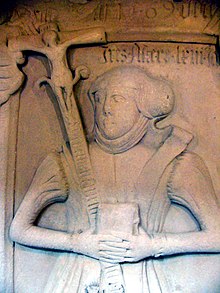Margarethe von Döhlau
Margarethe von Döhlau , also Döhla († September 18, 1569 ) was the last abbess of the Himmelkron monastery from 1544 to 1569.
Life
Margarethe came from the noble family von Dö (h) lau and had a house in Plauen . In 1543 she was appointed administrator to Himmelkron by the Clariss Monastery and was appointed abbess in 1544 under Margrave Albrecht Alcibiades . Your property is precisely recorded in a document and enables a precise overview of the property and thus the life of an abbess. In the course of the Reformation , Albrecht Alcibiades took advantage of the uncertain situation to get reports on the financial situation of the monastery and to influence upcoming decisions. In 1545 Margarethe was deposed again as abbess and financially compensated. She stayed in Plauen for the time being. There was a plan that Princess Barbara, a sister of George the Pious , should be provided with the money saved for the position of abbess in the monastery. In fact, she stayed in the monastery until her death on June 17, 1591. But Margarethe also returned in 1548. She had now accepted the Protestant creed. The convent subsequently shrank from 36 to 5 people; at the end there were only two nuns in the convent. Around 1550 she donated a baptismal bowl and a communion chalice to the monastery , which are still used today by the parish. Her coat of arms with three fish can be seen on both devices. Margarethe finally converted a small part of the monastery into a school for noble girls. The school only existed until the end of the 16th century and at the end of the day also took in commoners and boys. With Abbess Veronika von Dölau , the family was also represented in the nearby Hof Clariss monastery .
According to the inscription on the tomb, Margarethe died on September 18, 1569 at the age of 63. Her epitaph is in the church of Himmelkron Monastery . The central motif is their figurative representation. As the only abbess, she is not shown with a crook , but with a crucifix in view of the Protestant creed . In addition to their family coat of arms with three fish arranged one below the other, there are also the coats of arms of the von Bickenbach , the Rabensteiner and the Wildenstein . In the case of the latter two, other families should be considered due to similar coat of arms motifs.
literature
- Ernst Kießkalt: The sculptures of the former Cistercian convent Himmelkron . Bayreuth 1909. p. 13.
- Johann E. Teichmann: Historical description of the old women's closter Himmelcron . Bayreuth 1739. pp. 44-47.
- Theodor Zinck: Himmelkron - Description of his past and present . Bayreuth 1925. pp. 27-32.
Individual evidence
- ↑ Archive for History of Upper Franconia , Volume 54, Page 6, Historischer Verein für Oberfranken (Ed.), 1974 ( limited preview in Google book search)
- ^ Archive for the history of Upper Franconia , Volume 48, page 16 and 27, Historischer Verein für Oberfranken (Hrsg.), 1968 ( limited preview in the Google book search)
- ↑ Grosse Baudenkmäler , issues 241–308, 1969
- ^ Joachim Hotz: Cistercian monasteries in Upper Franconia. Ebrach, Langheim, Sonnefeld, Himmelkron, Schlüsselau , Volume 98 of Grosse Kunstführer , page 72 and 79, Verlag Schnell & Steiner, 1982 ( limited preview in Google book search)
- ↑ Collegiate Church Museum Himmelskron: Showcases with Vasa Sacra and seal ( Memento from February 27, 2014 in the Internet Archive )
- ↑ Helmuth Meißner: Depictions of coats of arms in and around the former Himmelkron monastery. In: Archive for the history of Upper Franconia . Volume 83, 2003.
| predecessor | Office | successor |
|---|---|---|
| Apollonia von Waldenfels |
Abbess of Himmelkron Monastery 1544–1545 1548–1569 |
--- |
| personal data | |
|---|---|
| SURNAME | Döhlau, Margarethe von |
| ALTERNATIVE NAMES | Döhla, Margarethe von |
| BRIEF DESCRIPTION | abbess |
| DATE OF BIRTH | 16th Century |
| DATE OF DEATH | September 18, 1569 |

